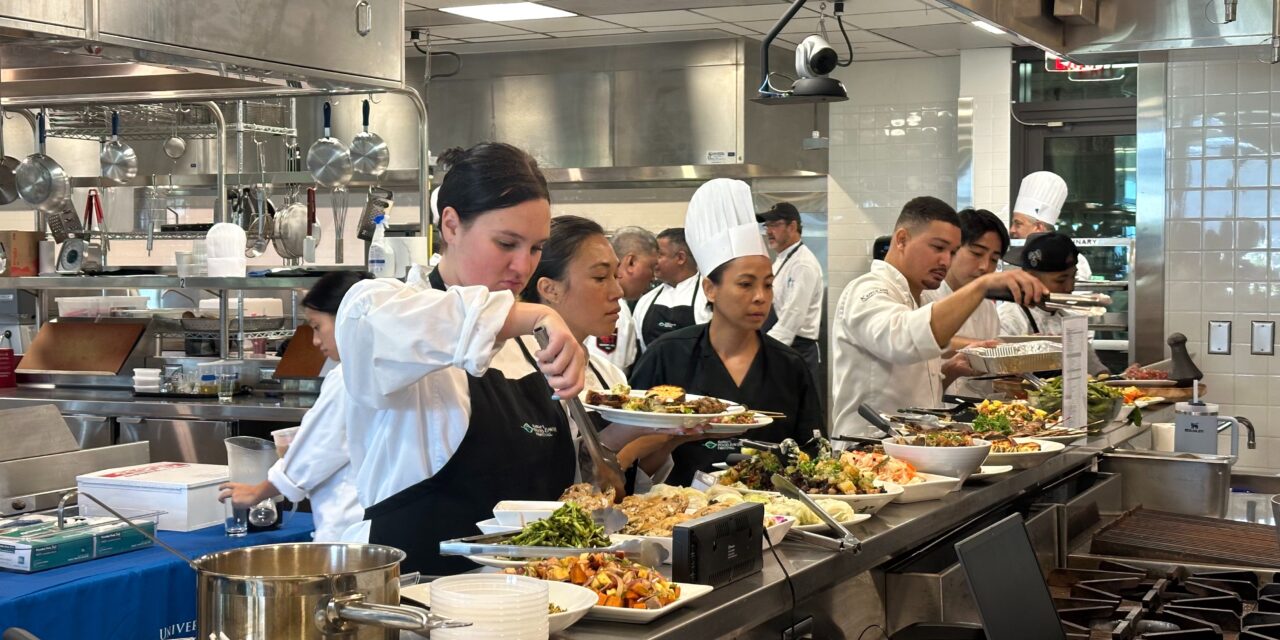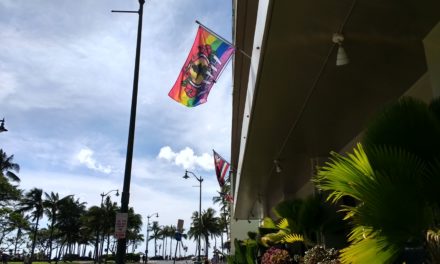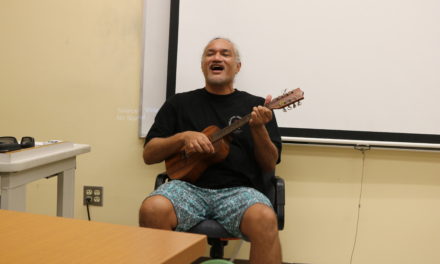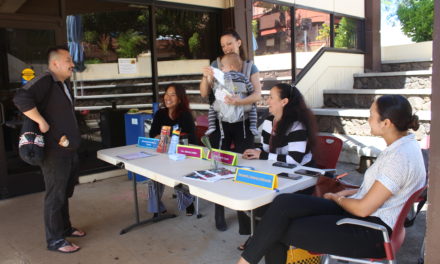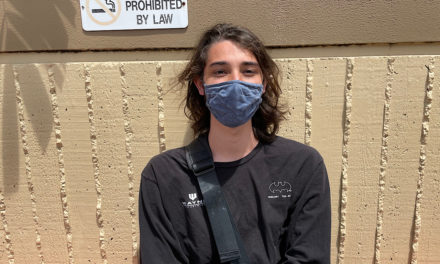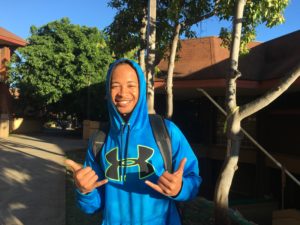Culinary Institute of the Pacific’s workforce development program, a collaboration with the Culinary Institute of America, is designed to elevate the growth of professional cooks in any industry. (Photo by Sarah Burchard)
By Sarah Burchard | Staff Writer
Roy Yamaguchi is a James Beard Award-winning chef and co-founder of Hawaiʻi Regional Cuisine who has opened over 30 of his namesake Roy’s Restaurants worldwide. In January 2024, he became the executive director of the Culinary Institute of the Pacific at Kapiʻolani Community College, arriving just in time to kick off the school’s next phase of development.
“As the executive director, what I’m trying to do is create a vision for the future of the Culinary Institute of the Pacific campus,” Yamaguchi said in an interview at CIP in September. “We want to create a world-class culinary campus for excellence.”
CIP is located at 4500 Diamond Head Road in the former Cannon Club (also known as the Fort Ruger officer’s club). It consists of two kitchen labs built in 2017 (phase 1) and a new innovation center, restaurant and auditorium still under construction (phase 2). (View renderings of CIP’s Phase 2 here.) Yamaguchi is here to lead the project into this new phase. According to KCC Town Hall meeting reports, the $20 million project was funded by private funders matched by the state of Hawaiʻi.
Yamaguchi decided to become a chef when he was 18 years old while attending The Culinary Institute of America in Hyde Park, New York in the 1970s. He opened his first Roy’s Restaurant in Hawaiʻi Kai in 1988 and his first franchise operation overseas in 1996. Today, he oversees 10 restaurants in Hawaiʻi, one in Pebble Beach, California and one in Guam, after selling 22 Roy’s Restaurant franchises in 2014. In 2011, he and his wife, Denise Yamaguchi, formed a 501C3 nonprofit organization called Hawaiʻi Ag & Culinary Alliance and together with Alan Wong they launched the first Hawaiʻi Food & Wine Festival. The festival, now 14 years running, has given 2,600 Hawaiʻi culinary student volunteers the opportunity to work alongside some of the country’s most renowned chefs. CEO of Hawaiʻi Food and Wine Festival Denise Yamaguchi said that in 2010, when they were envisioning the festival, it was to help CIP raise money for the project it is finally completing now.
In his new role at KCC, Yamaguchi oversees the credit and non-credit programs CIP offers. The for-credit program includes the two-year Associate in Science degree in Culinary Arts program, which enrolls 238 Kapiʻolani Community College students. KCC Culinary Arts department chair Grant Itomitsu said the core of the for-credit culinary program will remain the same, but by introducing new non-credit programs for the public in new state-of-the-art facilities, he hopes it will encourage people worldwide to think of KCC as a unique, high-level school.
Workforce Development Program
One of the partnerships Yamaguchi helped facilitate was with CIA to create a workforce development program for the public. Aside from being a CIA alum, Yamaguchi has also served on the board of trustees at CIA, which he called the “world’s most premier culinary college,” for 12 years.
“We need to create world-class partnerships,” Yamaguchi said. “World-class collaborations with businesses, institutions … whether it be educational or whether it be corporate. We need to have these world-class collaborations to move forward to do great things with.”
Denise Yamaguchi offered to take some of the KCC administration to CIA in California and New York to show them what a high-level culinary school looked like. In 2022, the University of Hawaiʻi chose associate vice president for administrative affairs Michael T. Unebasami, Hawaiʻi senator Donovan M. Dela Cruz and Hawaiʻi Senate higher education committee chair Donna Kim to accompany her, since they all represented the major stakeholders. Roy Yamaguchi joined them the following year to visit CIA’s San Antonio campus.
The workforce development program, a collaboration with CIA, is not only for hospitality professionals but any sector with food production, including health care, nonprofits and the U.S. military. Roy Yamaguchi said the goal is to not only raise the bar for local food establishments, which would benefit the economy, but also to raise the level and quality of food production overall in Hawaiʻi by having them train with the CIA instructors.
“Roy is a conduit for marketing the program,” Itomitsu said.
The workforce development program, which is comprised of weeklong intensive workshops, began at 4500 Diamond Head Rd. on Sept. 16. Each week a new cohort of 16 local students arrives Monday through Friday 9 a.m. to 3 p.m. (although most come early and stay later to engage with other students) to learn cooking techniques and professional skills from a visiting CIA instructor. Afterward, students earn a certificate of completion, which they can use to boost their resumes.
A Day in the Workforce Development Program
With his coiffed salt-and-pepper hair, pressed slacks and starched white CIP chef’s coat, Yamaguchi arrived at LAB 200 around noon in late September to observe and engage with the current cohort, a group of 16 culinary professionals from different backgrounds, including cooks from Duke’s, Zippy’s and Monkeypod Kitchen, Coast Guard and members of the Army, to name a few. The theme for the week was Pacific rim plant forward cooking.
Bricyn “Kale” Afong, a knife-maker, fisherman and private chef from Honolulu, prepared three styles of poke with ‘ahi he had caught three days prior and a pūpū of Kona kampachi bones, necks and tails coated lightly with cornstarch and fried golden brown, served with Sumida Farms watercress and ponzu.
“Fishermen,” he said. “We don’t like to waste.”
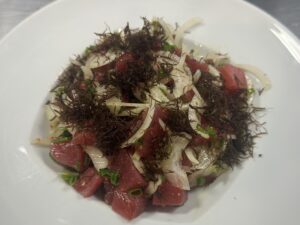
One of three ‘ahi poke prepared by Kale Afong. (Photo by Sarah Burchard)
When Afong was 15, he said he had very little money and would fish and dive in order to eat. He eventually landed a job selling insurance but lost it four years later when COVID hit. That’s when Afong began making sushi cakes.
“That’s what put me on the [cooking] journey,” Afong said. “I dipped into my past trauma when I was broke and fishing for my dinner and turned it into a business.”
Joe McGinn, owner of Hawaiʻi Natural Farming, brought ‘ulu and kalo from his farm to share. Preparing ʻulu paʻiʻai with a poi pounder, he shared his career goals.
“Originally, I wanted to do farming,” McGinn said. “So I grew all this cool stuff and then I couldn’t find anyone to do anything with it. So, part of it was me not knowing what to do with it. So now, by learning what it is and how to work with it, it’s completing the full circle.”
McGinn said he has learned not only from the instructor but also fellow classmates, the basics of working in a professional kitchen, like hanging a towel off his apron and how to set-up his station and keep it organized.
One of Yamaguchi’s goals for the program was to help students build networks. Victoria Zhang, assistant coordinator for the program, said she not only sees students walking away from the program with more knowledge but also new contacts.
“I noticed a lot of them have networked and expanded their circles more,” she said. “Like, ‘Oh! I’ve been looking for a local farm for a kalo source and you know a guy.’ So there’s just a lot of collaboration between everyone.”
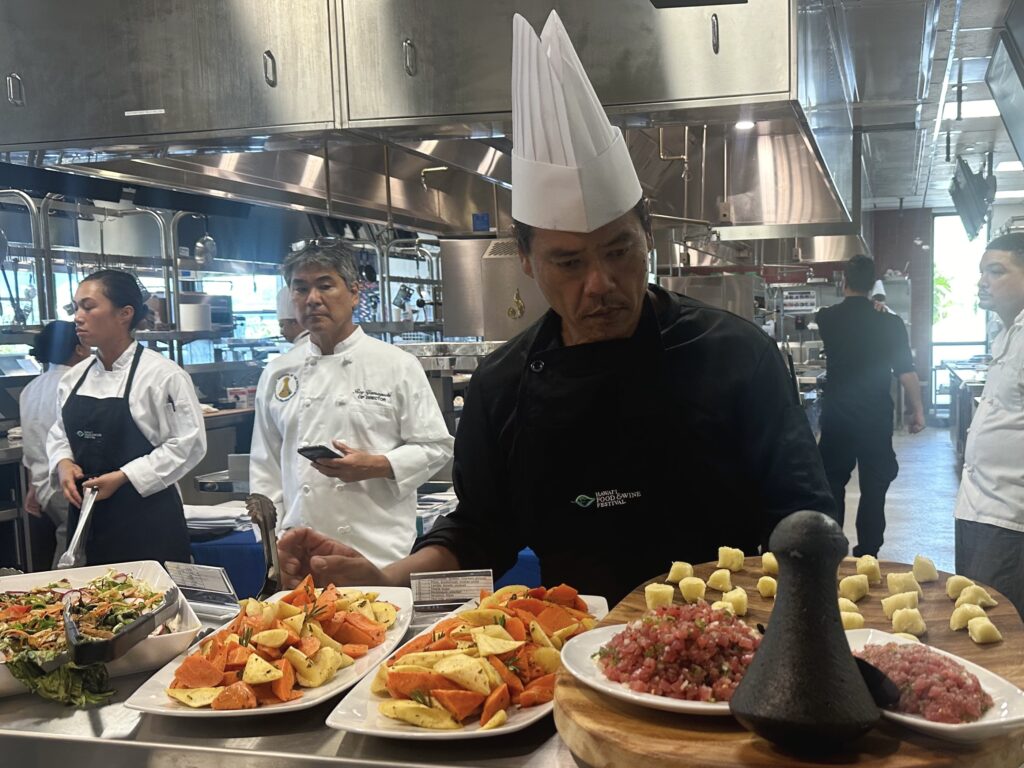
Joe McGinn (center) serves his homegrown ʻulu paʻiʻai alongside ʻahi poke, caught and prepared by classmate Kale Afong. Chef Roy Yamaguchi (left of McGinn) observes the food prepared by students in the CIP workforce development program. (Photo by Sarah Burchard)
Food For Thought Creative Center
Where the workforce development program works to elevate professional cooks and chefs, the Food For Thought Creative Center – the new innovation center coming next year – will focus on science, product development and beverage programs. Dr. Lauren Tamamoto – who has a background in nutrition, culinary arts, product development and a doctorate in food science – will create a curriculum for non-credit students intended to be useful in many areas of the hospitality industry. The first course she developed was on local coffee. Itomitsu said students will visit a coffee farm to learn how to grow, harvest and ferment coffee cherries, then visit a roaster, learn cupping and brewing techniques, and explore what kinds of food products can be made with coffee. The center will also be a testing ground for potential food products to bring to market and serve in the new restaurant once it opens.
The Restaurant
The restaurant (still unnamed), slated to open in 2025, will be open 365 days a year and employ both CIP students and an outside professional workforce as well. Yamaguchi said the “Pacific-influenced” menu will serve local products, have an eye toward sustainability and incorporate Hawaiian culture. He said they are still working on the menu and will be hiring a chef to lead the team soon.
Auditorium
Finally, the new auditorium will be a 11,350-square-foot space available to CIP chef instructors, other KCC department instructors and the public for presentations and seminars. Yamaguchi said there will be a state-of-the-art network broadcasting system, so presentations can be sent anywhere in the world. Yamaguchi hopes all buildings in phase two will be ready to open next year.
Along with the new changes comes potential for growth for not only CIP but other KCC departments too. Yamaguchi said disciplines such as business, accounting, science and health all tie into a well-rounded culinary education and opens up additional pathways for culinary students beyond cooking.
“My whole mindset has always been making sure that we can run it as a business,” Yamaguchi said. “Because I know that if we run it as a business, we can go somewhere. That’s my vision: teaching students the truth about business and life. That’s where I come from.”

